Table of Contents
ToggleIntroduction
I was really looking forward to do this review. The EpoX EP-8KTA3 is part of my Win98 testing machine for many years now, where I test older graphics cards, soundcards and so on. I also use it to test SDR memory. It literally never let me down and never gave me any issues. But in this usecase, it is clear that certain aspects get overlooked and this shall change with this review.
The EpoX 8KTA3 was among the very first KT133A based boards released to the market. Unlike many other manufacturers, EpoX did not “just” update the chipset on their existing KT133 based product (EP-8KTA2) and sell it with a slightly altered Name (like Asus and Abit for example). They developped a completely new board and still brought it to market very early. Updated “PRO” versions of the 8KTA3 were also release some time later, which featured enhanced OC capabilities. The 8KTA3 is available in a total of four different versions:
- EP-8KTA3
baseline Version
- EP-8KTA3+
Additional Highpoint ATA RAID chip
- EP-8KTA3PRO
Improved OC options (FSB settings and voltages), no RAID
- EP-8KTA3+PRO
Improved OC options (FSB settings and voltages), additional Highpoint ATA RAID chip
The improved OC options of the “PRO” models include:
- “true” jumperless FSB setting (on the non-PRO models, you select the base FSB of 100 or 133 MHz and OC from there)
- FSB setting in 1 MHz increments, max configurable FSB is 180 MHz as compared to 166 MHz of the non-PRO models
- VCore offset jumpers for up to +0,4 V on top of the configured VCore
Gallery
Specifications and Features
Chipset:
- VIA KT133A Northbridge
- VIA 686B Southbridge
CPU Support (with latest BIOS):
- Athlon Thunderbird (ALL)
- Duron Spitfire (ALL)
- Duron Morgan (ALL)
Memory Support:
- 4 SDR DIMM slots, up to 1,5 GB total (6 Banks)
Expansion Slots:
- 1x AGP slot (1,5 / 3,3V) up to 4x
- 6x PCI slots
- 1x ISA Slot (shared with PCI #6)
Connectors (internal):
- 2x IDE (UDMA100)
- 1x Floppy
- 1x USB 1.1
- 3x 3-pin fan connectors total (1x CPU, 2x chassis)
Connectors (external):
- 2x PS/2
- 2x COM/RS-232
- 1x Parallel Port
- 2x USB 1.1
- 3x 3,5" Audio Jacks (Line-Out, Line-In, Mic)
- Gameport
You might have noticed, that I didn't mention the audio chipset specifically, as I think far better solutions than the old onboard chipsets are readily available for little money. Very commonly recommended are the Creative Soundblaster Live! cards for example, which offer fantastic compatibility with our beloved old games and sound far better than any onboard solution of that era.
I also don't list (from a retro-gamers perspective) useless connectors and features like IR, Smartcard- or Wake-on-LAN connectors and so on.
Overclocking Features:
- Adjustable Multiplier (DIP / BIOS) from x6 - x14
- Adjustable FSB (BIOS) 95-120 MHz in 16 steps and 124 - 166 MHz in 11 steps
- Adjustable VCore (BIOS) +- 0,100 V in 0,025 V steps
- I/O Voltage (BIOS) up to + 0,35 V in 0,05 V steps
- AGP Voltage (BIOS) up to + 0,5 V in 0,1 V steps
All settings that have to do with voltages or CPU setup can be found in the BIOS, which makes setting the system up easy and “modern feeling”. The only thing that has to be set by jumper is the initial FSB speed that the board boots with (100/133). And depending on that, the configurable FSB range differs (see above).
Documentation, Downloads, Drivers
Another iconic brand from back in the day that closed doors many years ago, is EpoX. Unlike Abit for example, it is not an easy task to find downloads and information on EpoX mainboards.
In terms of BIOS downloads, this is a pretty huge archive: https://www.elhvb.com/mobokive/archive/epox/bios/index.html
It is definitely incomplete and does not necessarily offer the latest BIOS versions for every model, but still a good place to start. To find the most recent versions for certain models, you have to fire up your favorite search engine.
For documentation, you should also find most manuals there: https://www.elhvb.com/mobokive/archive/epox/manuals/index.html.
Just use Ctrl+F on that site to “navigate”, most of the time there are several versions of the manual for each model available and the naming is not exactly “uniform”. The manual for the 8KTA3 in particular can be found in this subdirectory:
https://www.elhvb.com/mobokive/archive/Epox/manuals/KL133-KT133-KLE133-KM133-KL133A/index.html
Please note, that the aforementioned site only offers downloads for older EpoX Models. For documentation of “more recent” EpoX motherboards you have to look elsewhere, like here for example:
https://www.manualslib.com/brand/epox/motherboard.html
Regarding CPU support you can find the info here: https://www.cpu-upgrade.com/mb-Epox/index.html
I already use this site for a long time and I always found the info to be very accurate. I cannot remember that I had a motherboard, that was not featured there. Great site.
To obtain drivers, take a look at this site: https://soggi.org/drivers/drivers.htm
It offers driver downloads for a huge share of old chips (network, storage, chipset, etc.),
To sum it up: using a motherboard of a manufacturer that is not around anymore might not be as straightforward as using an Asus or Gigabyte motherboard, for example. Especially with Epox motherboards you will have to search a little bit longer for everything you need to build your system. But I think it is worth the time, because EpoX released a number of very good motherboard models, which can be a solid foundation for your retro-build.
Design & Layout
Objectectively speaking, I have to admit that the Epox 8KTA3's layout is flawed in many aspects. But I still like it because of its VRM section with those massively huge capacitors and the VRM heatsinks. It just looks “serious” and has a comparable appeal like a classic V8 big block engine to me. I just cannot help it.
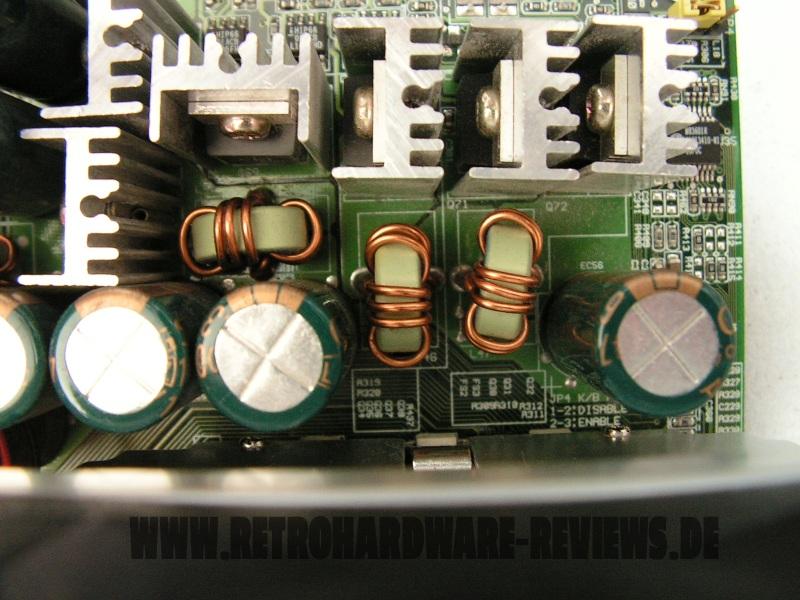

So let's not start with its (numerous) layout shortcomings, but with some positive aspects. The 8KTA3 comes with a total of four memory slots, which is (to my knowledge) unique among KT133A based motherboards. The VIA chipset supports only six memory ranks, so the maximum memory remains 1,5 GB with a maximum module size of 512 MB. The memory slots 3 & 4 are shared and if both are populated, the modules have to be single-ranked and of the same spec. Still, it adds some flexibility, but was probably more useful back in the day than it is today, where big SD-RAM Modules are cheap and easy to obtain.
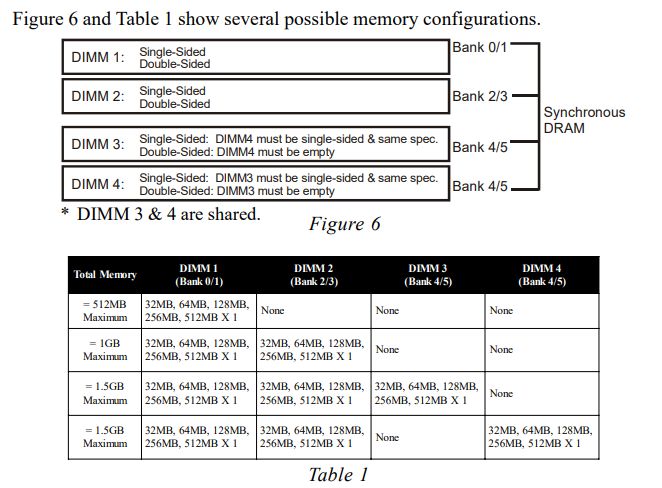
Another good thing is the selection of expansion slots, which are (aside of the AGP x4 3,3 V slot) six PCI slots and also an ISA slot, which is shared with the sixth PCI slot. This is the perfect set of expansion slots for a nice retro system.
The CPU socket is oriented so that its plastic mounts face the memory slots and VRM area, which I actually prefer. This way, the cooler can usually be removed and installed without having to partially or completely disassemble the entire system (because access to the mounting clamp is blocked).
Furthermore, Cooler Master heatsinks, which often had a large lever on the mounting clamp, can be installed regardless of the space available between the motherboard and PSU. Unfortunately, like already on the 8KTA2, there is a small capacitor in close proximity to the CPU socket, so that the Alpha 8045 cannot be installed.
Other than that, the space around the CPU socket is sufficient. I tested the following seven coolers towards compatibility and was able to install all but two of them:
- Thermaltake Silent Boost K7
- Cooler Master HHC-001
- Swiftech MCX 370
- Alpha PAL 6035
- Alpha PAL 8045
- Smartcooler 60mm
- Arctic Cooling Copper Lite

Apart from the Alpha 8045, which I mentioned before, the Arctic Copper Lite can't be mounted either. The large capacitors to the left of the socket are to tall and do not fit under Artic's budget heatsink.


Another bad layout decision was carried over from the 8KTA2: the CMOS battery socket is also located to the left of the AGP slot, so that the graphics card has to be removed to replace the battery. The position of the floppy connector is improved compared to its predecessor, so that even longer videocards like the Voodoo 5 5500 does not interfere with it. But the IDE connectors are placed in the same horrible way as on Epox' previous board. Long PCI expansion cards can not be installed without interfering with them, so you have to get creative and / or create a ribbon cable mess. Furthermore, the IDE cables cover the cool (and useful!) debug display as well as the “Clear CMOS” jumper.

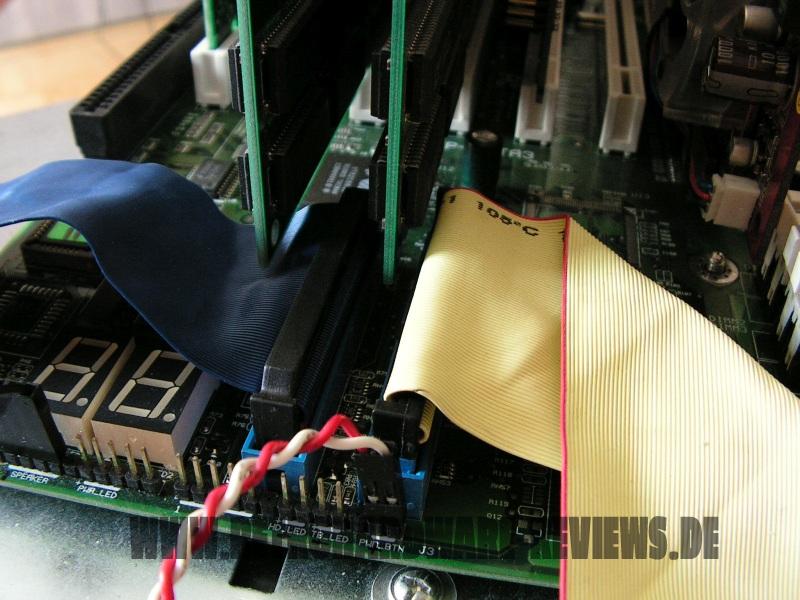

The ATX Power connector is also placed identical to the 8KTA2, creating the same airflow problems with the power cable covering the hot VRM area. Another similarity to the 8KTA2 (and many other boards from back then) is, that the memory slots get blocked by the AGP card, so that memory modules can only be installed, when the videocard is removed.

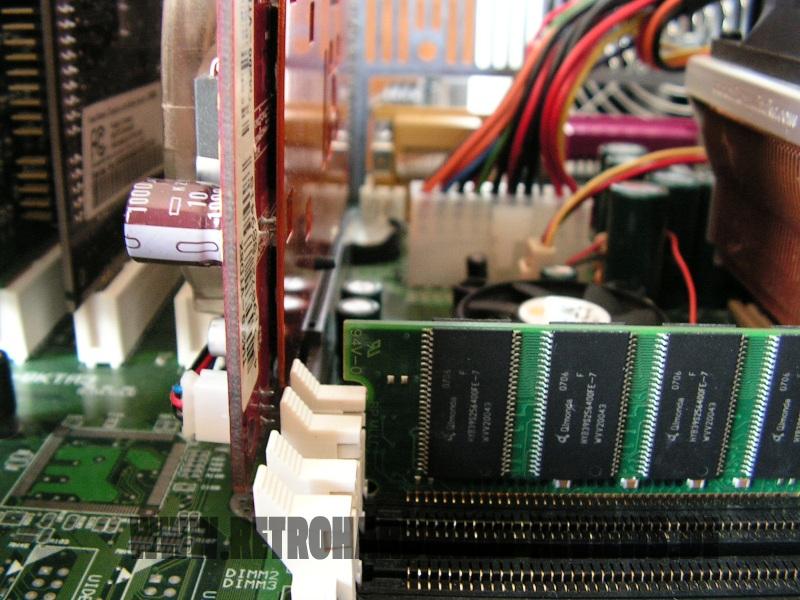
Test-System and Parts
Baseline Setup:
- CPU: AMD Athlon Thunderbird 1200C (FSB133)
Because I want to compare 1st Gen Socket A mainboards to their DDR follow-ups I have to use a CPU, which is available in FSB100 and FSB133 versions with the same clockspeed. Since I sadly don't have a Thunderbird 1400 B at my disposal, I will use the Thunderbird 1200 for my reviews and comparisons of these boards, which I have in the “B” (FSB100) and “C” (FSB133) version.
- RAM: 1x “Infineon 3rd” 512 MB PC133 SD-RAM
This memory stick has Qimonda chips rated at 7ns (=143 MHz). It runs flawlessly with the tightest timings at 133 MHz and its size of 512MB is the perfect choice for Windows 98SE.
- VGA: MSI Geforce 4 TI4200-VTD8X
To remove any GPU bottleneck for testing, I chose a Geforce 4 Ti as the primary graphics card for my test setups. The Geforce 4 Ti series are also known to pull a lot of power from the AGP port, so that possible problems in that department can also be revealed. It is also somewhat period correct and a good match for a high performance retro-machine that should be able to run late Windows 98SE games without any issues.
- VGA2: 3dfx Voodoo 5 5500 AGP
Many people consider the Voodoo 5 5500 the perfect card for (Win9x-) retro gaming. The Voodoo 5 benefits from a beefy setup, so a powerful Athlon Thunderbird or early Athlon XP is the perfect match for this card.
- Audio: Creative Soundblaster Live! (SB0060)
Creative's Soundblaster Live! can be found in many retro-machines. It offers great sound, perfect Win98SE compatibility and is still widely available for reasonable money. It was also known to cause problems with VIA-based 686B southbridges using old BIOS revisions and VIA chipset drivers. All this should be history at this point, but double checking on pontentially affected mainboards is still not a bad thing to do.
- LAN: 3Com Etherlink XL PCI
Just a good, reliable choice for networking. All legacy Windows versions all the way up from Win95 have built-in drivers for it, which is also a huge “plus”.
- HDD: Western Digital WD200BB (20GB 7200RPM)
No special intention behind this drive, it is just “there” and still works fine.
Additional Hardware for certain Tests:
- Silicon Image Sil3512 SATA Controller & Samsung PM871 128GB SSD
These two will help me measure the PCI bandwidth.
- Hitachi Deskstar T7K500 (500GB 7200RPM)
This drive will tell us, how big we can go with the onboard IDE connectors and how the performance is like.
- 2x Voodoo 2 12MB (SLI)
A pair of Voodoo 2s is a must have for any retro-machine, that doesn't feature a 3dfx card as the primary VGA solution. They offer compatibility to older Glide games and can be used with any more powerful primary graphics card. It is an important thing to know, how well these perform and if there are differences between all the available Socket A chipsets of that era or even between boards using the same chipset.
Drivers used:
- Chipset: VIA Hyperion 4in1 4.56v
- Geforce 4: nVidia Forceware 43.45
- Voodoo 5: Amigamerlin 2.9
- Voodoo 2: FastVoodoo 4.6
- SB Live!: Some driver from my archive, not shure 😉
- 3Com NIC: Windows 98SE preloaded driver
- SATA Controller: Some driver from my archive, not shure 😉
System Setup and Usage
The first few parts of the setup process were as trouble free as expected. All connectors and jumpers are well labled on the PCB, so there is no need to look something up in the manual. The manual itself is by the way not to useful in general, because the description of the BIOS options is okay, but is mostly descriptive.. in the truest sense of the word. I've seen worse, but also better. The good news is, that the markings on the PCB tell you everything you need to know to setup your system.
Furthermore, there is no documentation on INT routing and sharing between onboard devices and PCI slots, so you will have to figure this out by yourself. Since I already reviewed the 8KTA2 before, I was hoping that the INT routing and IRQ sharing was done similar to it - and I was lucky.
In the BIOS, I was already able to see that the INT assignment is identical to the 8KTA2, which is:
- INT-A: AGP
- INT-B: free
- INT-C: onboard audio
- INT-D: 2x USB controller
And the PCI ↔ INT assignment was also identical:
- PCI #1: shared with AGP
- PCI #2: no sharing
- PCI #3 and #5: shared with onboard audio
- PCI #4 and #6: shared with both USB controllers
So I disabled all unused onboard components like serial ports, LPT, floppy controller and onboard audio and distributed the expansion cards over the PCI slots like this:
- PCI #1: free
- PCI #2: SATA controller
- PCI #3: Voodoo 2
- PCI #4: Voodoo 2
- PCI #5: SB Live!
- PCI #6: 3com NIC
Before I get to driver installation and so on, I have to mention that I altered several option in the BIOS, compared to how it was configured in my testsystem. I discovered, that there were many options configured rather slow and safe as opposed to during these reviews, where I try to configure everything memory- and PCI related to the best possible performance.
Anyway - after the first Windows boot, when no new devices are detected anymore (I use a predone Image, where only drivers have to be installed for my reviews), I installed all drivers in a row and restarted afterwards. Upon next boot, there was something that felt like a freeze for at least 20 seconds during the logon. The welcome sound stopped playing, the mouse was stuck, no reaction anymore.
I decided to wait a little and indeed - the system became responsive again, the welcome sound playback continued from where it stopped, everything looked fine. But during the next few minutes, this happened again, during normal operation. This time it even felt longer. Since the system did not crash completely, and I know all hardware is fine, I reviewed all PCI related changes I made in the BIOS.
The first option that I set to disabled again, was “Dynamic PCI Bursting”. This options should improve PCI efficiency and throughput, as 8 Bit and 16 Bit writes are merged to 32 Bit writes. On some motherboards (like Asus for example) this is called “Byte Merge”. Unfortunately, this has made the situation worse rather than better. Next, I re-enabled “Dynamic PCI Bursting” and disabled “PCI#2 Access #1 Retry” in the BIOS. This is actually quite an interesting setting, as enabling improves CPU performance, disabling improves PCI performance. Here is a great explanation of this feature by Techarp: PCI#2 Access #1 Retry
Exerpt:
Generally, it is recommended that you enable this feature as this improves the processor's performance. However, if you have many PCI devices and their performance is more important, you may want to disable this feature. This prevents excessive generation of retries by the write buffer which may severely tax the PCI bus. Disabling this feature will improve the PCI bus' performance, especially with slow PCI devices that hog the bus for long periods of time at a stretch.
At first, this seemed to have worked. But during a UT timedemo, the system completely froze and did not recover this time. I suspected the Soundblaster Live! to be the troublemaker and let it swap PCI slots with the 3Com NIC. At the same time, I re-enabled “PCI#2 Access #1 Retry” - and this really helped! Although PCI #5 should have been the better choice because the SB Live! wouldn't have to share its IRQ, PCI #6 worked better even though the audio card now had to share its IRQ with the USB controllers. SB Live! and old VIA chipsets -> a success story 😉
Fortunately, this was the only issue I faced. After this was sorted out, the rest of my tests were smooth sailing.
Benchmarks
Synthetic Measurements
Before we get into the 3DMark and gaming benchmarks, let's have a look at some theoretical numbers. These synthetic tests will exhibit the differences between the several chipsets and boards better than any game benchmark and provide us with "background information" that might be of use in understanding the timedemo results later.
Memory Performance: AIDA64 Cache & Memory Benchmark
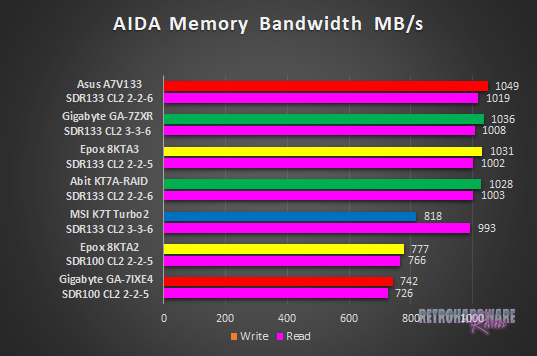
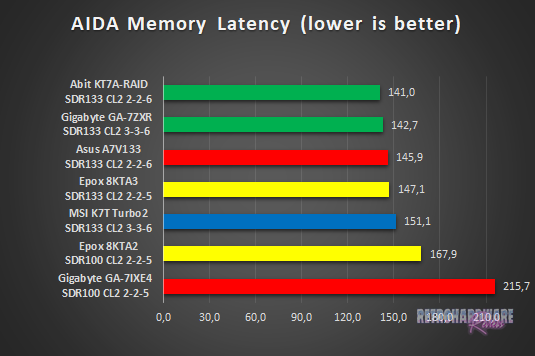
The memory bandwidth values look allright and are about the same as for the Abit KT7A, which trails the 8KTA3 on fourth place. The measured memory latency, however, is not exactly the best. Especially considering it has the tightest memory timings of all KT133A boards, at least on paper.
Application Performance: 7-Zip
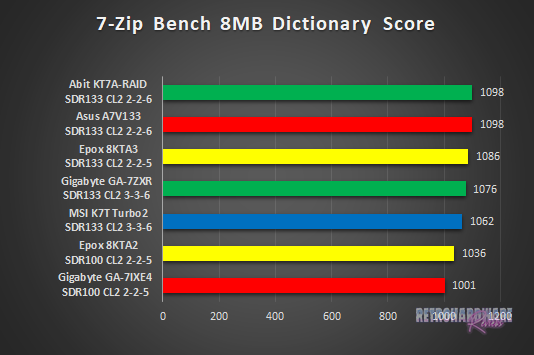
The EpoX board ranks third and surpasses the GA-7ZXR, which performed better in both memory bandwidth and -latency. Definitely a good result.
AGP Performance: Final Reality Benchmark
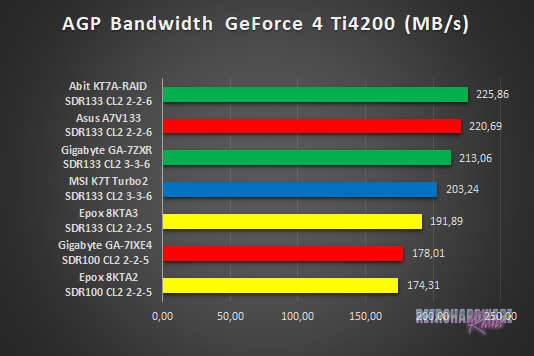

AGP performance is a bit lacking with the GeForce 4 Ti compared to the other KT133A based boards, but with the Voodoo 5 installed, it takes first place.
AGP and PCI Performance: 3DMark 2000 and ATTO
3DMark 2000 as a whole is very focused on TnL and is by far not as interesting for retro-hardware comparisons as its predecessor. Its “High Polygon Count, 1 Light” test, however, is another good way to measure the AGP performance. In opposite to the Final Reality test, the general system performance is also somewhat of importance. The benchmark was executed with the Geforce 4 Ti installed.
To measure PCI performance, I installed a Windows 98SE compatible SATA controller with a Samsung PM871 128GB SSD connected into the system. For the bench, I chose 1024 to 4096 KB block size and picked the overall best values for the read and write throughput. This test will show, which maximum performance can be expected with fast storage options like SATA or SCSI and maybe gives a hint, if the chipset might be good for Voodoo 2 cards.
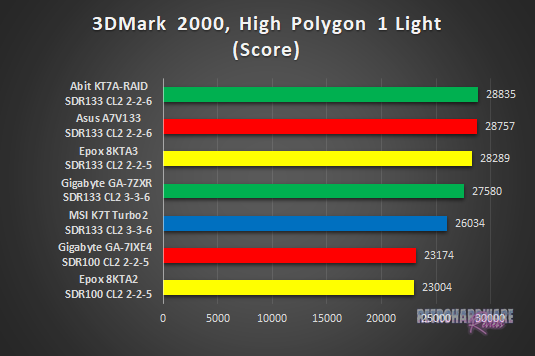
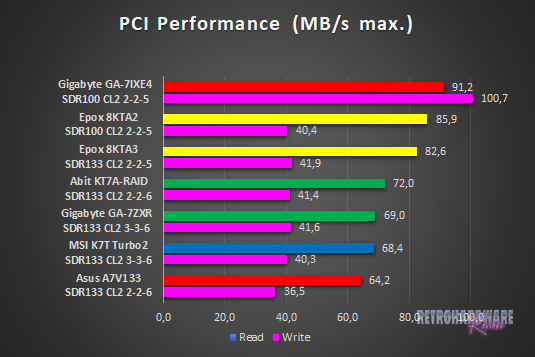
We see pretty good results for the 8KTA3 in both tests. In the 3DMark2000 sub-test, it ranks third, not too far behind the top two boards. This is a very good outcome after the rather low AGP bandwidth values we saw before, and the mixed results in the memory tests.
In the PCI bandwidth test, it shows the same weakness in write throughput, that all VIA KT133(/A) based boards seem to have, but at least it achieves a decent read performance and ranks third here.
Storage Performance: HDTach
To measure the performance of the board's IDE and (if available) onboard IDE RAID solutions' performance, I benched one of the latest and fastest IDE drives (the Hitachi Deskstar T7K500 500GB) with the HDTach benchmark. I also tried a much more “recent” drive (the Western Digital Blue Edition 500GB), which should be even faster in theory, but the Hitachi drive produced much better results in this test.
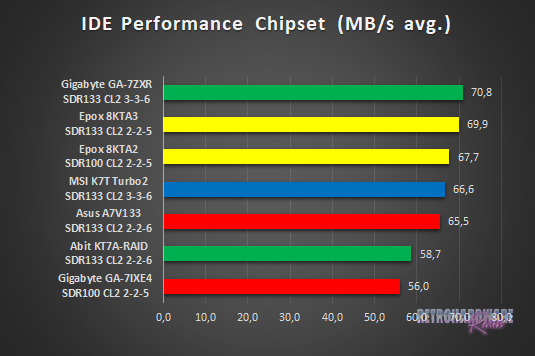
The IDE performance is also very good, with a read rate of just under 70 MB/s. Only the GA-7ZXR is a little bit faster.
Gaming Benchmarks
Now that we got all the theoretical performance numbers, let's see how the contenders perform in 3D gaming benchmarks.
3D Performance: 3DMark99max
3DMark99max was released in early 1999 and comes without support for Hardware TnL. The maximum supported (hardware-) DirectX level is DX6. It is a great benchmark to reveal good overall system performance, as it rewards good memory bandwidth and latency more than the slight clockspeed advantage, that some boards have because of their factory-overclocked FSBs.
- Version: "latest"
- Settings: standard
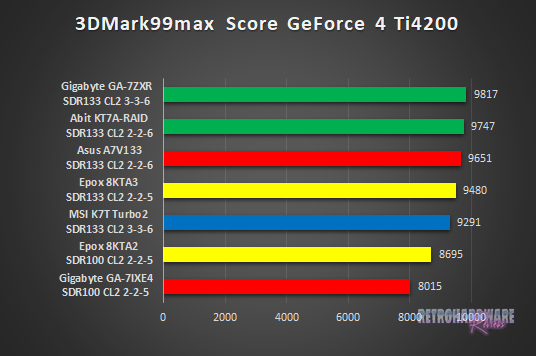
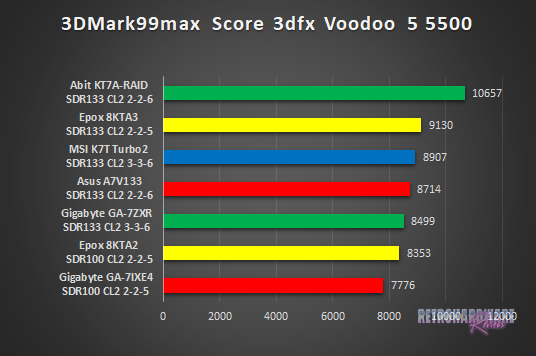
The 3DMark99max results with the GeForce 4 Ti installed are somewhat underwhelming, it reaches fourth place and therefore is the second slowest KT133A based board. Things are looking a lot better with the Voodoo 5 on rendering duties, this time the 8KTA3 is able to take second place, behind the Abit KT7A which is untouchable in this test.
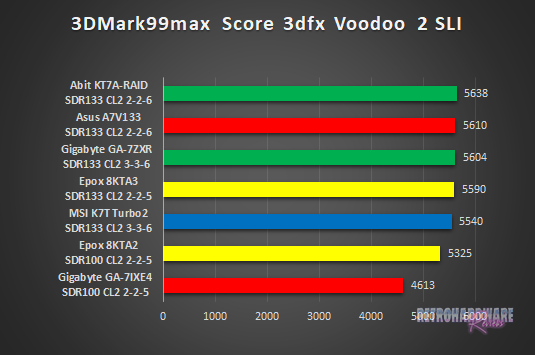
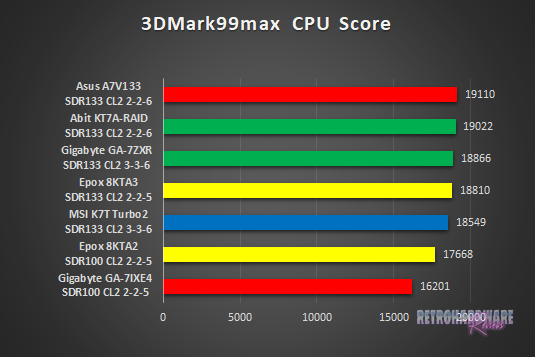
The EpoX 8KTA3 ranks fourth in the Voodoo 2 SLI run and in terms of CPU score, closely trailing the Gigabyte GA-7ZXR in both cases.
3D Performance: Unreal Tournament (UT99) Timedemo(s)
Unreal Tournament (UT99) was released in November 1999 and is notorious for its hunger for CPU power. I chose to use two different timedemos for comparison, of which the utbench.dem timedemo is heavily CPU bound and therefore qualifies to measure the general performance of the boards. The second timedemo benchmark.dem is as GPU limited as possible in this game. This will reveal, how much impact a faster board can still have in more GPU limited situations. This game is also perfect to show, on which chipsets and boards Voodoo 2 cards run best.
- Version: 4.36
- Settings: High, Min desired Framerate "0", Show Decals [x], Use Dynamic Lightning [x]
- Geforce: D3D
- Voodoo 2 and Voodoo 5: Glide
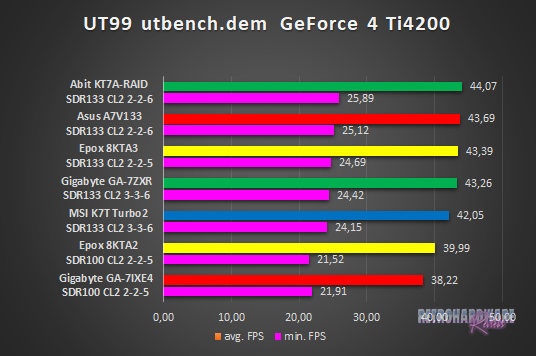
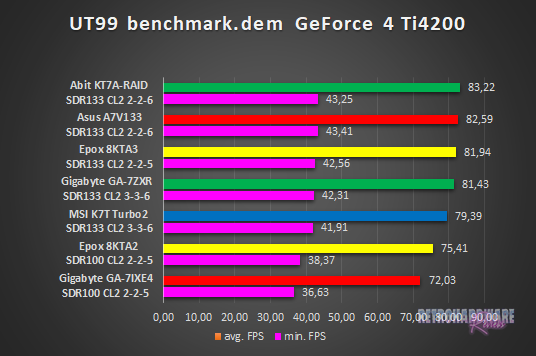
The first "real-world" gaming benchmark puts the 8KTA3 in place three in both UT timedemos, but the results are not very far spread among the top four boards with the GeForce 4 installed.
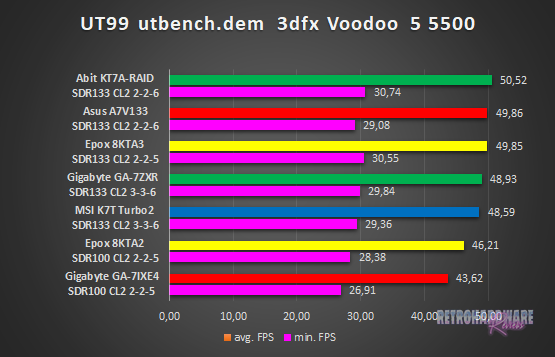
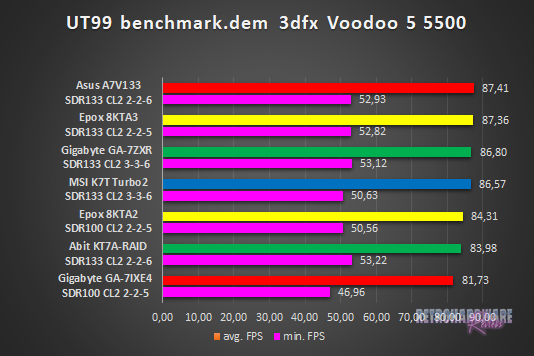
Things even get better with the Voodoo 5 installed: In the utbench timedemo, the 8KTA3's average FPS a practically identical to those of the second-ranked A7V133, its minimum FPS are also the second best of all contenders. It is one of only two boards, that can keep the FPS from falling below 30 FPS throughout the test.
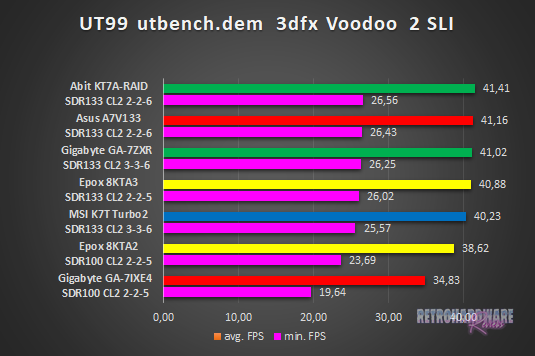
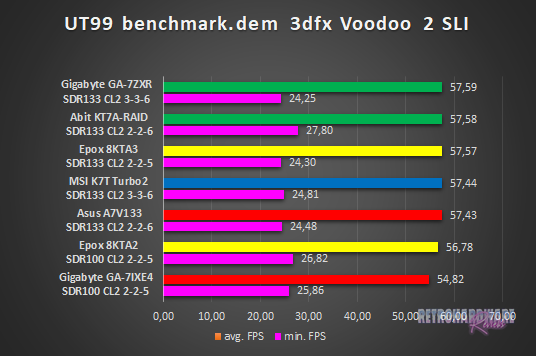
In the Voodoo 2 SLI run of the utbench timedemo, the 8KTA3 takes fourth place and is around 0,5 FPS behind the first-placed Abit KT7A-RAID in both minimum and average FPS.
It ranks third in the second timedemo, with basicallly identical average FPS to the first and second ranked GA-7ZXR and KT7A-RAID, but achieves the second lowest minimum framerate of all boards.
3D Performance: Quake III Arena Timedemo
Quake 3 Arena was released shortly after Unreal Tournament, in December of 1999. It is known to reward fast memory latency and with its normal preset, it is completely CPU limited; at least for the GeForce 4 and the Voodoo 5. The Voodoo 2 SLI cards clearly limit the Athlon 1200 here, as the timedemo will show.
- Version: 1.32
- Settings: “Normal” Preset, only resolution changed to 1024x768x16
- Geforce 5 and Voodoo5: OpenGL
- Voodoo 2: “Voodoo” Renderer (miniGL)
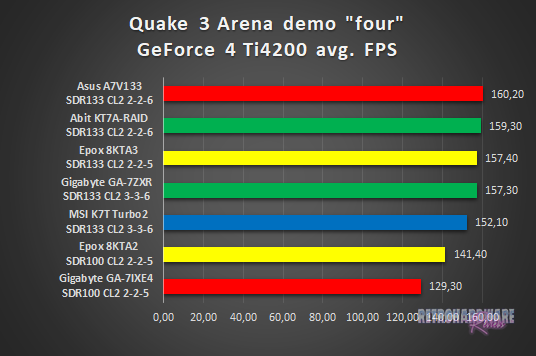
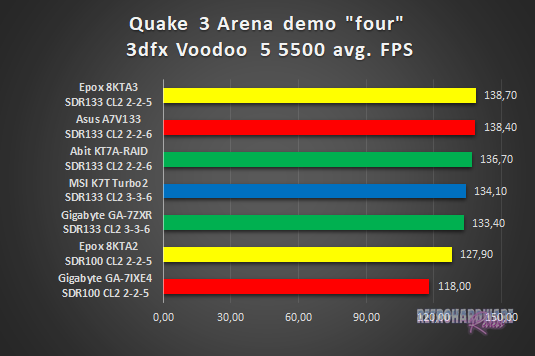
With the GeForce 4 Ti installed, the EpoX board ranks third, with only a 0,1 FPS lead over the GA-7ZXR. In the Voodoo 5 run however, it shows a great performance and takes first place with 138,70 FPS. Only the A7V133 comes close with 138,40 FPS, all other boards are at least 2 FPS behind.
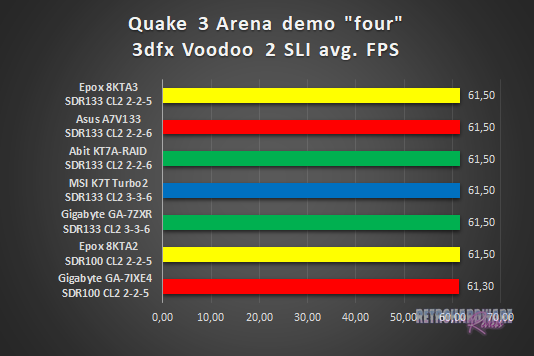
The Voodoo 2 SLI setup clearly limits here. All boards score the same FPS, with only the Gigabyte GA-7IXE4 being a close 0,2 FPS behind.
Summary & Rating
EpoX EP-8KTA3 (VIA KT133A)
-
Layout
-
Features
-
Overclocking Options
-
Compatibility
-
Documentation & Support
-
Performance: GeForce 4 Ti 4200
-
Performance: Voodoo 5 5500
-
Performance: Voodoo 2 SLI
OVERALL
| Pros | Cons |
| + Perfect set of expansion slots (1/6/1 AGP/PCI/ISA) | – Some layout shortcomings |
| + Four memory slots | – Compatibility issues with some CPU coolers |
| + DIAG LED Display | – Possible issues with PCI expansion cards |





